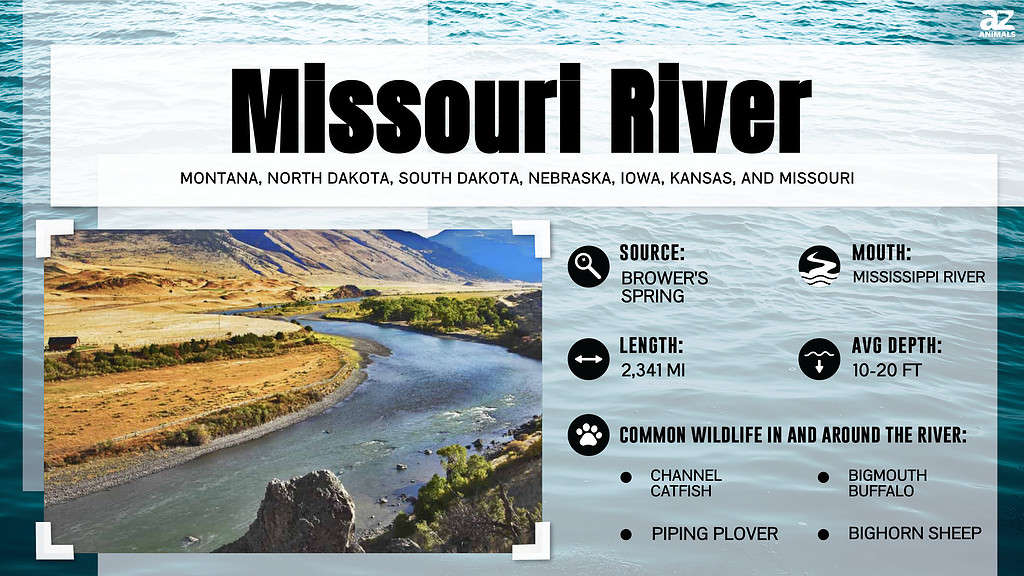
The Missouri River is known for being the longest river in the United States at about 2,540 miles long. The Missouri River sure has its share of unique and beautiful features, just like any other river system. Missouri has a wide variety of wildlife and is home to more than 900 animal species, with about 413 species, or at least 46% of them, found within and around the Missouri River.
The river is home to 413 species of mammals, birds, reptiles, and amphibians. Reptiles like snakes are common, as 47 species of snakes make the river and its surroundings their home.
Today, we’re going to talk about five snakes of the Missouri River; their habitat, diet, size, and unique characteristics that you need to know about.
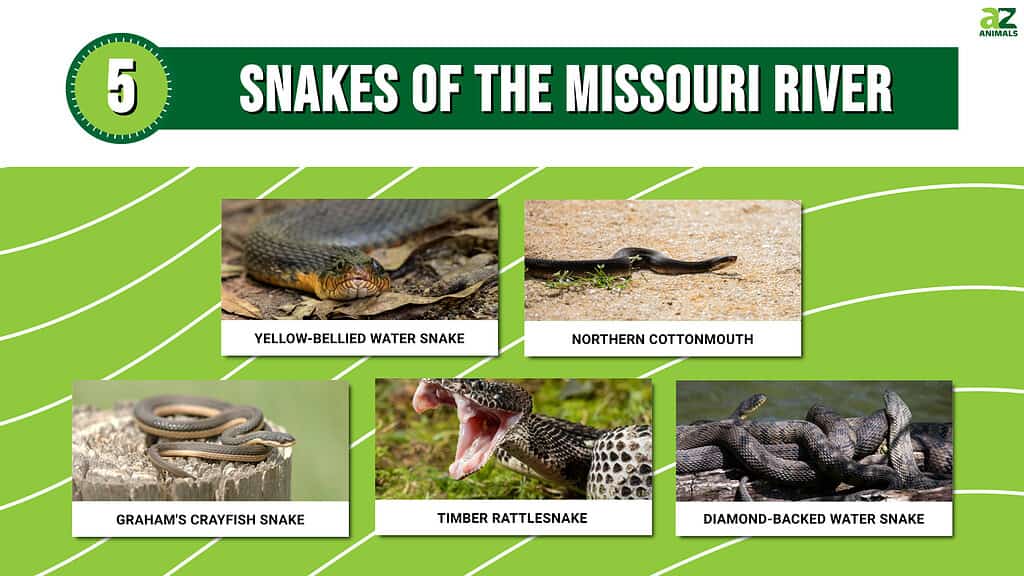
1. Yellow-Bellied Water Snake

| Yellow-Bellied Water Snake | |
|---|---|
| Scientific name | Nerodia erythrogaster |
| Length | Up to 4 feet |
| Diet | Fish, frogs, tadpoles, crayfish, salamanders |
| Lifespan | 3.5 years |
Also known as the plain-bellied water snake, the yellow-bellied water snake is a nonvenomous unicolor snake that can be found near different water sources within the state of Missouri, such as floodplains, wetlands, ponds, lakes, and especially rivers. Unicolored yellow-bellied snakes can be brown, reddish, or grey with an orange-yellowish color on the bottom. Some can even be patterned with dark-bordered light bands and, sometimes, uncolored scales.
Even if it is a water snake, it spends more time on land than other water snakes in the state, especially during hot weather, since they are primarily found in drylands away from their usual habitats. One unique and fascinating thing about these water snakes is their different styles of hunting prey. Instead of actively chasing and hunting down prey like water snakes, they would just sit at a particular spot to ambush prey that would pass by them. This behavior is more frequent on land than on the water.
Another fascinating thing about them is that they feed on terrestrial and aquatic prey, so no matter where they go, there will always be food. They mainly feed on fish, frogs, tadpoles, crayfish, salamanders, and other species of amphibians.
2. Northern Cottonmouth
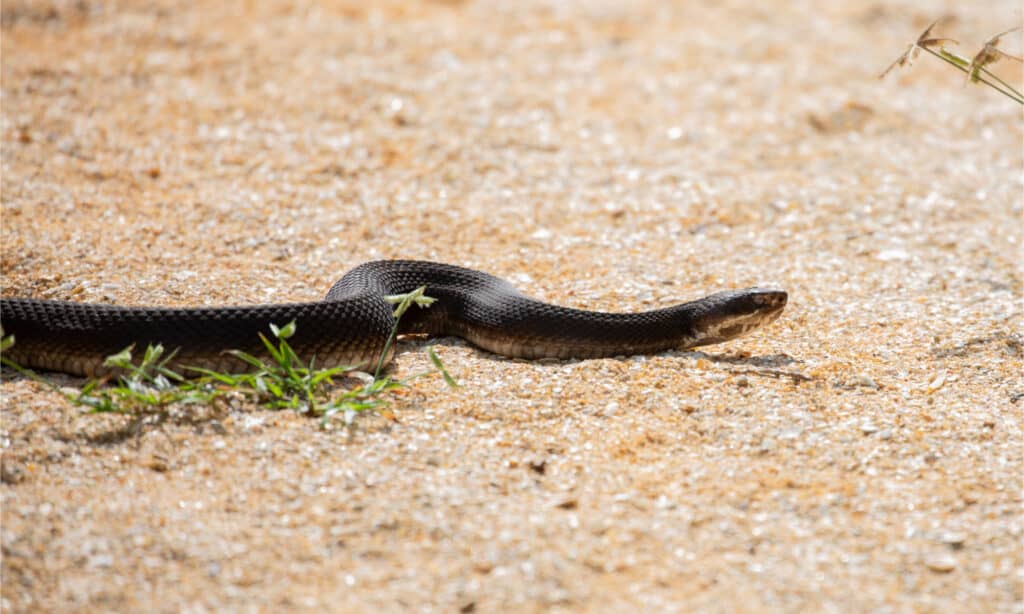
Northern cottonmouths mainly feed on fish, frogs, lizards, rodents, and other snakes.
©Linda Burek/Shutterstock.com
| Northern Cottonmouth | |
|---|---|
| Scientific name | Agkistrodon piscivorus |
| Length | 2-4 feet |
| Diet | Fish, frogs, lizards, rodents, other snakes |
| Lifespan | 10 years |
Also known as the water moccasin, the northern cottonmouth is one of the three subspecies of venomous water snakes around the Missouri River. The name “cottonmouth” is derived from the cotton-white lining of its mouth, which opens wide when threatened by a potential attacker. Their color ranges from olive, brown, or black with various intensities of crossbands. Younger cottonmouth snakes have patterned heads that will slowly fade as they mature. They are mostly found in moist regions such as swamps, floodplains, beach areas, streams, and river corridors.
Northern cottonmouths are often mistaken for water snakes, which are harmless. What makes them different from these similar snakes is that they are highly venomous and can give off a fatal bite. They mainly feed on fish, frogs, lizards, rodents, other snakes, baby alligators, birds, and even tiny turtles. One fascinating characteristic of these cottonmouths that can differentiate them from water snakes is that they vibrate their tails when they get too excited.
3. Graham’s Crayfish Snake
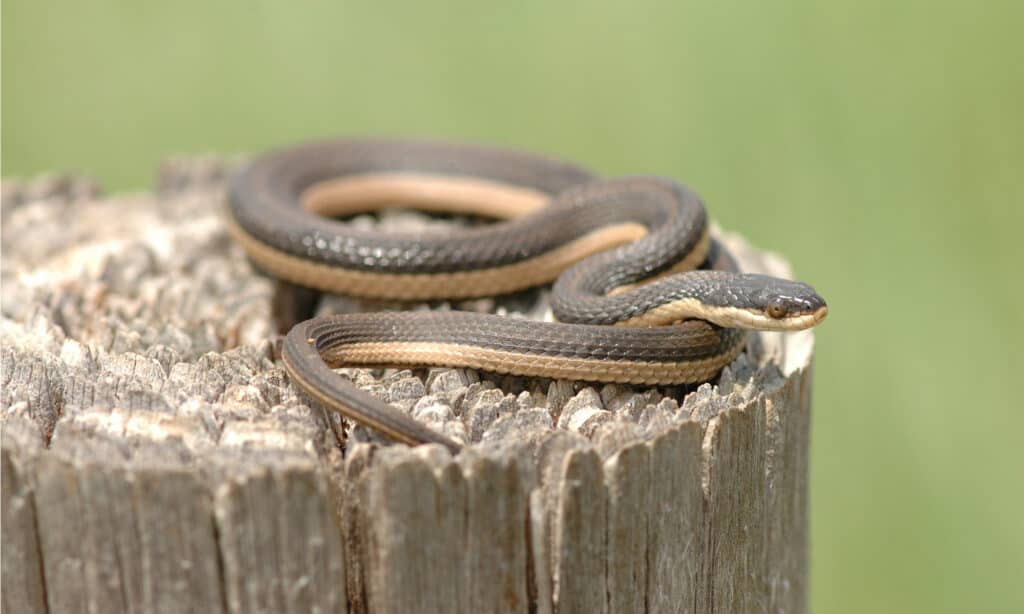
The Grayham’s crayfish snake mainly feeds on soft-bodied crayfish.
©Rusty Dodson/Shutterstock.com
| Graham’s Crayfish Snake | |
|---|---|
| Scientific name | Regina grahamii |
| Length | Up to 2 feet |
| Diet | Crayfish, frogs, tadpoles |
As its name suggests, the Grayham’s crayfish snake mainly feeds on soft-bodied crayfish, although it also feasts on frogs and tadpoles. It has the distinct color of black or dark brown with a light-yellowish belly as if it is split in half.
This reclusive species is considered one of the rarest to find all around Missouri as they prefer to burrow themselves under rocks, logs, and even crayfish burrows. They are also found burrowing themselves in places near moist environments such as marshes, sloughs, streams, ponds, and rivers. They are often mistaken for the venomous cottonmouth, even if they are relatively smaller, so hunters often needlessly kill them.
4. Timber Rattlesnake
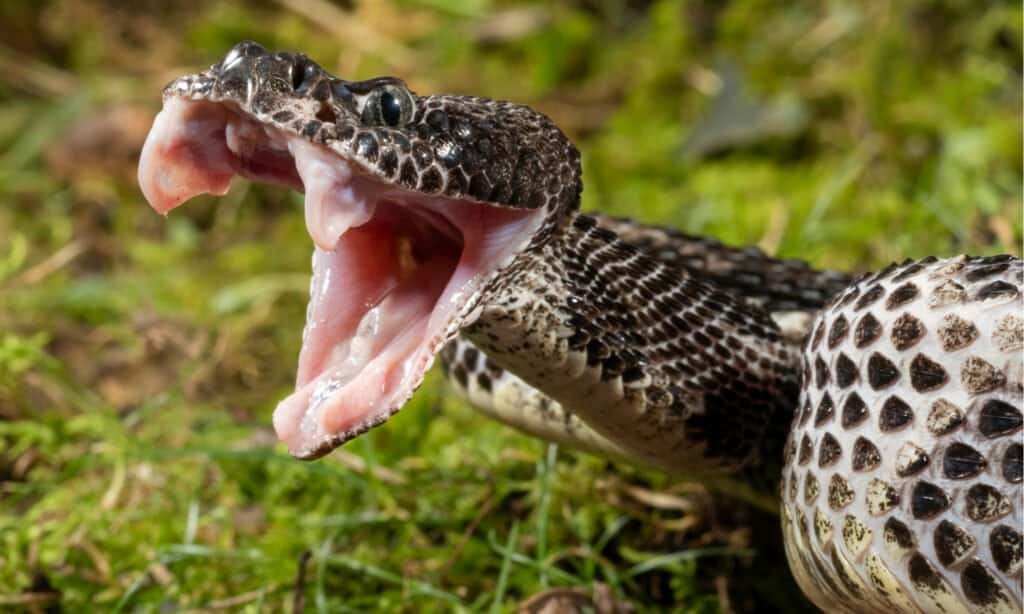
Timber rattlesnakes are primarily nocturnal during summer.
©Joe McDonald/Shutterstock.com
| Timber Rattlesnake | |
|---|---|
| Scientific name | Crotalus horridus |
| Length | 3-5 feet |
| Diet | Rabbits, mice, birds, lizards, squirrels |
| Lifespan | 30+ years |
The timber rattlesnake is the largest venomous snake in Missouri, measuring from 36 to 60 inches, or 3 to 5 feet in length. It can be found anywhere in the state and mostly lives on wooded hillsides, forests, or river bottoms. It has a generally grey or yellowish-tan color and dark brown markings along its back that change from blotches from the neck to bands near its tail. A dark line extends from its eye, aligning with the angle of its jaw, and a rust-colored stripe at the back. You can also identify this snake by the large rattle on its tail.
This venomous snake mainly feeds on rabbits, mice, birds, lizards, squirrels, chipmunks, shrews, and other larger mammals. They are most active between April and October and are primarily nocturnal during summer.
Although venomous, this snake is also reclusive and prefers to be solitary for the rest of its life, so they use camouflage to avoid being seen. However, if being handled or harassed, they will not hesitate to bite their attackers. They have a dangerous and potentially fatal venom that needs to be medically sought immediately.
5. Diamond-Backed Water Snake
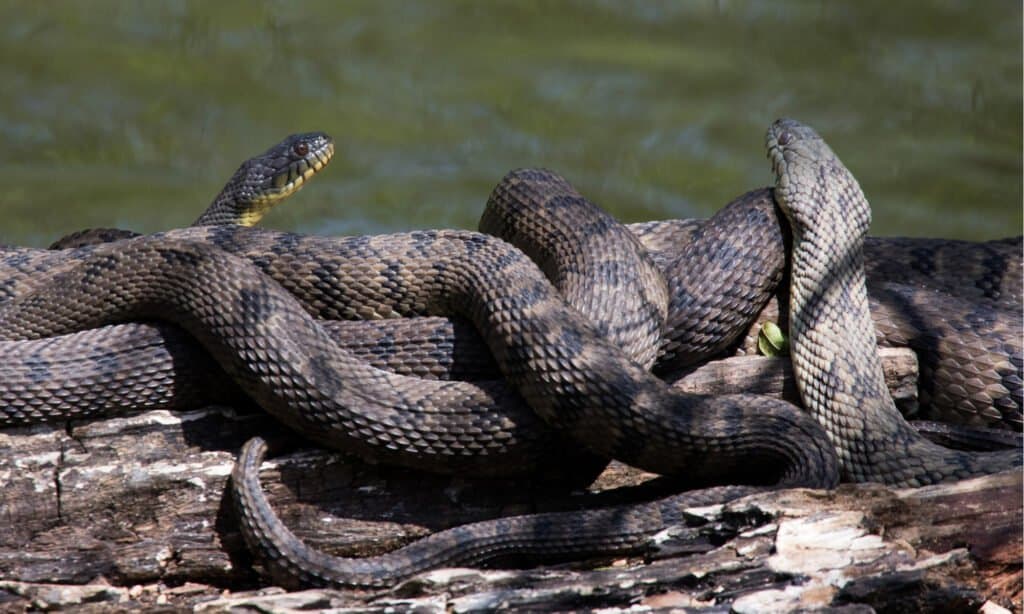
The diamond-backed water snake prefers living in slow-moving bodies of freshwater with vegetation.
©Laurie L. Snidow/Shutterstock.com
| Diamond-Backed Water Snake | |
|---|---|
| Scientific name | Nerodia rhombifer |
| Length | 2.5-4 feet |
| Diet | Fish, frogs, toads, salamanders, young turtles, minnows |
| Lifespan | 10 years |
The largest of all five species of native water snakes in Missouri, the diamond-backed water snake prefers living in slow-moving bodies of freshwater with vegetation such as ponds, swamps, streams, wetlands, and rivers. They are either light brown, brown, yellowish, or olive green in color, with dark brown diamond-shaped markings down their backs. They have a yellow belly with dark half-moon markings.
Their diet consists of fish, frogs, toads, salamanders, young turtles, minnows, worms, leeches, and insects. Unlike the previously mentioned snakes here, these water snakes are not venomous and will likely just go away when they see a potential threat. However, they will release a foul-smelling musk from their glands near the tail and bite if captured. Despite this, they are common within Missouri and aren’t considered a dangerous species, unlike other venomous snakes mentioned before. Unfortunately, people misidentify them as venomous cottonmouths and rattlesnakes, which has decreased their population.

Rat snakes live 10 – 20 years in the wild or in captivity.
©dkHDvideo/Shutterstock.com
How Long Do Snakes Live?
Snakes are fearsome predators but they face a few threats such as eagles, hawks, owls, cats, raccoons, and other carnivores. Most people kill them if they see them – and they tend to get run over by cars when crossing roadways. When you take all of this into consideration and add a loss of habitat – snakes live an average of 2 – 8 years in the wild.
There are some exceptions, like the rat snake, which is common and lives 10-20 years in the wild or in captivity. Boa constrictors, having no predators, can live up to 20 years in the wild.
Snakes in captivity generally live 15 – 30 years depending on the quality of care and the snake.
Summary of Five Snakes of the Missouri River
Here is a list of five snakes of the Missouri River ranked by length.
| Rank | Snake | Length |
|---|---|---|
| 1 | Yellow-Bellied Water Snake | Up to 4 feet |
| 2 | Northern Cottonmouth | 2 – 4 feet |
| 3 | Graham’s Crayfish Snake | Up to 2 feet |
| 4 | Timber Rattlesnake | 3 – 5 feet |
| 5 | Diamond-Backed Water Snake | 2.5 – 4 feet |
The photo featured at the top of this post is © Rusty Dodson/Shutterstock.com
Discover the "Monster" Snake 5X Bigger than an Anaconda
Every day A-Z Animals sends out some of the most incredible facts in the world from our free newsletter. Want to discover the 10 most beautiful snakes in the world, a "snake island" where you're never more than 3 feet from danger, or a "monster" snake 5X larger than an anaconda? Then sign up right now and you'll start receiving our daily newsletter absolutely free.
Thank you for reading! Have some feedback for us? Contact the AZ Animals editorial team.






